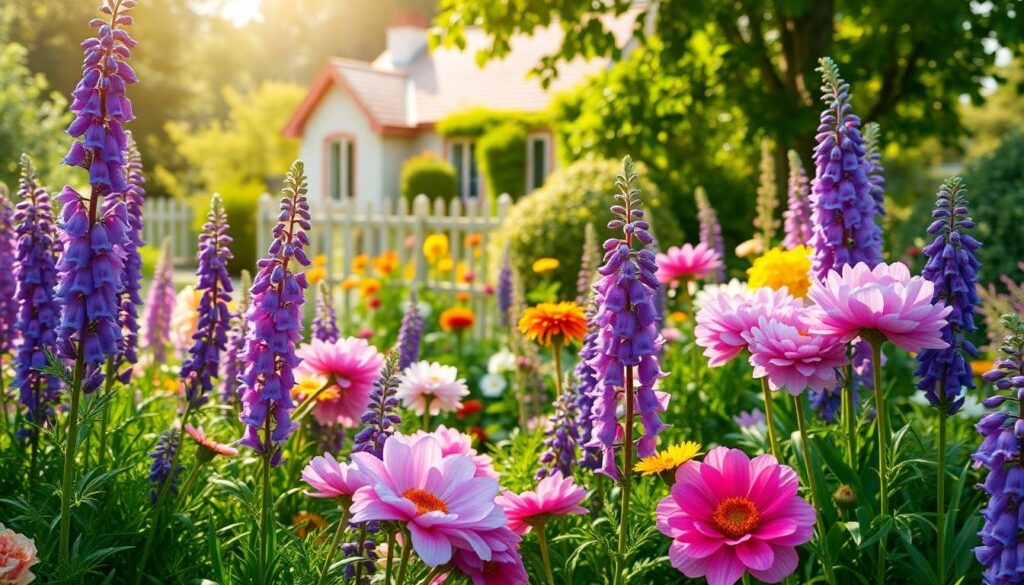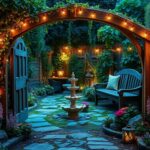Imagine stepping into your yard and being greeted by a vibrant tapestry of colors, textures, and fragrances. That’s the magic of a well-designed flower garden! Whether you’ve got acres of land or just a tiny balcony, we’ll show you how to transform your space into a breathtaking floral paradise.
In this comprehensive guide, we’ve gathered the most inspiring flower garden ideas to suit every style, budget, and skill level. From cottage-style gardens bursting with perennials to modern minimalist arrangements, we’ll help you discover the perfect approach for your outdoor sanctuary. We’ve done the research so you don’t have to, combining expert advice with practical tips that’ll have your garden blooming in no time.
10 Stunning Cottage Garden Flower Ideas for Year-Round Blooms
1. English Lavender
English lavender creates a stunning visual impact with its purple blooms and silvery-green foliage. This versatile perennial not only adds fragrance to your cottage garden but also attracts beneficial pollinators like bees and butterflies. Planting lavender in sunny spots with well-draining soil ensures it thrives year after year. For maximum impact, consider creating a lavender border along pathways or mixing it with roses for a classic cottage garden look.
2. Foxgloves
Foxgloves deliver dramatic vertical interest with their tall spires of tubular flowers in shades of purple, pink, white, and yellow. These biennial beauties self-seed readily, creating a sustainable display year after year. Growing foxgloves in partially shaded areas where they can receive morning sun produces the best results. Their woodland charm makes them perfect companions for ferns and hostas in the shadier sections of your cottage garden.
3. Delphinium
Delphiniums bring height and majestic color to cottage gardens with their towering spikes in blues, purples, pinks, and whites. These impressive perennials bloom profusely in early summer, creating a dramatic backdrop for lower-growing flowers. Staking delphiniums early in the season prevents damage from summer storms and keeps them looking their best. Their traditional cottage garden presence pairs beautifully with roses, peonies, and other classic cottage flowers.
4. Hollyhocks
Hollyhocks stand as cottage garden icons with their tall stalks covered in saucer-shaped blooms from midsummer through fall. These old-fashioned favorites create instant charm with their vintage appeal and diversity of colors. Planting hollyhocks along fences or walls where they can receive support helps maintain their upright growth. Though technically biennials or short-lived perennials, they self-seed enthusiastically, ensuring continuous displays for years.
5. Peonies
Peonies offer extravagant blooms and incredible fragrance as cottage garden staples that can live for decades. Their lush, full flowers in pinks, whites, and reds create focal points throughout late spring and early summer. Giving peonies a sunny location with rich, well-draining soil supports their long-term growth potential. Their luxurious blossoms complement other early-summer bloomers like iris, allium, and columbine.
6. Shasta Daisies
Shasta daisies provide classic simplicity with their bright white petals surrounding golden centers from early summer through fall. These easy-care perennials form clumps that gradually spread, filling garden spaces with cheerful blooms. Deadheading spent flowers encourages additional blooming waves throughout the growing season. Their clean, crisp appearance offers perfect contrast to more colorful cottage garden companions like salvias and coneflowers.
7. Roses
Roses serve as the heart of cottage gardens with their unmatched combination of beauty, fragrance, and romantic nostalgia. Choosing disease-resistant varieties like ‘Knock Out’ or ‘David Austin’ English roses ensures beautiful blooms with minimal maintenance. Mixing climbing roses on trellises with bush varieties creates multi-dimensional interest throughout your garden. Their wide range of colors from soft pastels to vibrant hues allows coordination with any cottage garden color scheme.
8. Coneflowers (Echinacea)
Coneflowers deliver long-lasting summer color and valuable winter interest with their distinctive seed heads that feed birds through cold months. These native perennials come in purple, pink, white, orange, and yellow, blooming from midsummer until frost. Growing coneflowers in full sun with average soil produces sturdy plants that rarely need staking. Their drought tolerance once established makes them perfect choices for low-maintenance cottage garden areas.
9. Russian Sage
Russian sage introduces airy texture and silvery-blue color that complements virtually every cottage garden flower. This drought-tolerant perennial blooms from midsummer through fall with minimal care requirements. Placing Russian sage toward the middle or back of borders allows its 3-4 foot height to create a beautiful backdrop. Its subtle coloring works especially well with brighter flowers like black-eyed Susans and zinnias.
10. Catmint (Nepeta)
Catmint offers waves of lavender-blue flowers from late spring through fall with incredibly long bloom periods. This hardy perennial forms neat mounds that work beautifully as border edgings or pathway plantings. Trimming catmint back after its first flush of flowers encourages a second and often third round of blooms. Its gray-green foliage provides excellent contrast to plants with darker green leaves, creating visual interest even when not in flower.
Creating a Butterfly-Friendly Flower Garden: Plants That Attract Pollinators

Transforming your garden into a butterfly haven not only adds beauty but also supports essential pollinators in your network. We’ll explore the best plants and design elements to create a thriving butterfly sanctuary.
Top Nectar-Rich Flowers for Butterflies
Butterflies seek out exact flowers that provide abundant nectar and support their lifecycle. Aster (Symphotrichum) stands out as an excellent nectar source with its daisy-like blooms that butterflies can’t resist. Bee Balm (Monarda) attracts butterflies with its vibrant colors and sweet nectar, making it a must-have in any pollinator garden. Black-eyed Susan (Rudbeckia) offers both nectar and a landing platform with its distinctive flat center and bright petals.
Blazing Star (Liatris) produces tall purple spikes that serve as butterfly magnets during summer months. Butterfly Bush (Buddleia) lives up to its name by drawing many butterfly species with its fragrant flower clusters. For supporting butterfly reproduction, consider adding host plants like Snapdragon, which specifically nurtures buckeye larvae. Native plants adapted to your region typically serve as ideal host plants for local butterfly species, creating a complete habitat for these delicate insects.
Creating Butterfly Shelter Areas
Sunlight plays a crucial role in butterfly garden success, as most butterfly-friendly plants require 6 to 8 hours of direct sunlight daily. Water sources should be shallow and feature rocks or sand where butterflies can safely land to hydrate without drowning. Shelter becomes essential for butterflies during adverse weather conditions, so incorporate diverse plant structures including shrubs and trees.
Variety in your garden design attracts different butterfly species, so mix flower shapes, sizes, heights, and colors throughout your space. Native plants form the foundation of an effective butterfly garden by mimicking natural ecosystems that local species recognize. Diversity of plant species ensures your garden supports many butterfly varieties throughout their lifecycles. Creating both horizontal and vertical plant diversity with varying heights and growth habits provides multiple niches for different butterfly activities. Selecting plants with staggered bloom times maintains a consistent food source from spring through fall, ensuring butterflies have nectar available throughout the growing season.
Small Space Flower Garden Ideas: Maximizing Beauty in Limited Areas
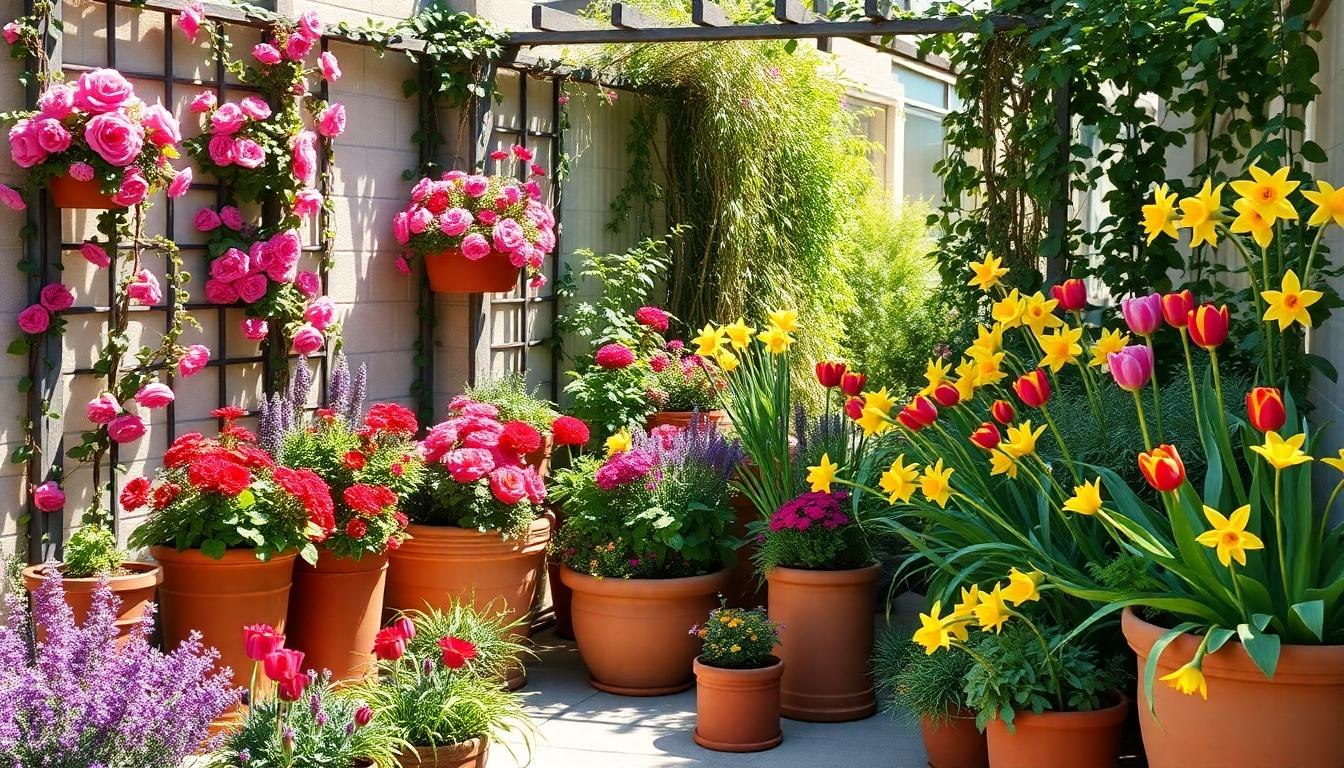
Limited space doesn’t mean limited gardening possibilities. With strategic planning and creative approaches, even the smallest areas can transform into breathtaking flower gardens that maximize both beauty and functionality.
Vertical Flower Gardens for Urban Spaces
Vertical gardening offers an excellent solution for urban dwellers with minimal ground space. Trellises, arbors, and vertical planters enable plants to grow upward rather than outward, effectively utilizing vertical real estate while creating visual interest. Climbing roses, ivy, and edible vines such as beans add wonderful texture and dimension to any compact garden setting. Fence-line gardens work perfectly in narrow areas, combining tall ornamental grasses for privacy with shorter blooms like salvia or cornflower that attract essential pollinators. For ultra-compact spaces, hanging gutters mounted on walls or stacked pot systems provide ideal homes for herbs and trailing flowers such as petunias, maximizing every available inch of your urban oasis.
Container Garden Combinations for Tiny Yards
Container gardening opens up endless possibilities for tiny yards through strategically themed groupings. Pollinator-friendly combinations featuring lavender, zinnias, and bee balm create vibrant mini-ecosystems that support local biodiversity. Monochromatic arrangements using varying shades of a single color—such as pink phlox, roses, and impatiens—deliver visual cohesion and dramatic impact in limited spaces. Edible bloom containers filled with marigolds, nasturtiums, and pansies serve dual purposes, offering both ornamental beauty and culinary ingredients. When planning container gardens, always select pots with adequate drainage holes and group plants with similar light requirements together. Raised beds provide improved drainage and soil control, making them ideal answers for small yards or patios. For added visual interest, tiered terra-cotta planters create stunning color gradients with flowers like red tulips, orange lilies, and yellow daffodils, while repurposed items such as wheelbarrows offer charming, movable garden spaces that can be repositioned as needed.
Low-Maintenance Flower Garden Ideas for Busy Homeowners

Creating a beautiful garden doesn’t have to consume your weekends. We’ve curated practical flower garden answers specifically designed for homeowners with limited time to spend on garden maintenance.
Native Plants for Effortless Beauty
Native plants offer exceptional low-maintenance options for busy gardeners. Cornflowers thrive naturally in local conditions, requiring minimal intervention while attracting beneficial pollinators to your garden. Salvia varieties deliver striking blooms with remarkable drought tolerance once established. Russian sage stands out with its silvery foliage and purple flowers that require almost no maintenance throughout the growing season.
Carry out layered planting designs to maximize visual impact with minimal effort. Tall ornamental grasses like Panicum create a stunning backdrop when planted behind shorter perennials. Coreopsis and dianthus work perfectly in front positions, creating natural depth and dimension without complicated care routines.
Drought-Tolerant Flower Selections
Yarrow (Achillea) tops our list of drought-resistant performers with its flat-topped flower clusters that thrive even during hot, dry spells. Lavender plants combine incredible fragrance with exceptional drought tolerance, flourishing in poor soil conditions that would stress most other flowers. Catmint delivers waves of purple-blue blooms that persist through summer heat with minimal watering needs once roots establish.
Tickseed (Coreopsis) deserves special attention for low-maintenance gardens, offering continuous blooms from spring through fall with almost no intervention. These sunny yellow flowers resist most common garden pests while flourishing in full sun locations. Their ability to perform beautifully even though neglect makes them perfect for gardeners with busy schedules.
Perennial Beds That Thrive with Minimal Care
Long-lived perennials form the backbone of truly low-maintenance flower gardens. Black-eyed Susans provide reliable golden blooms year after year with almost no care required beyond occasional deadheading. Bee balm (Monarda) attracts beneficial pollinators while spreading naturally to fill garden spaces. Astilbe thrives in partly shaded locations, offering feathery plumes of color without demanding frequent attention.
Baptisia and euphorbia add structural elements to low-maintenance borders with their architectural forms and exceptional drought resistance. These robust perennials work perfectly in meadow-style landscapes where natural beauty is prioritized over manicured perfection. For areas along fences or property boundaries, combine vertical-growing perennials with ground covers like sedum or switch grass (Panicum virgatum) to create maintenance-free garden zones.
Key Strategies for Reduced Garden Maintenance
- Wildflower integration: Incorporate self-seeding varieties like cornflower to minimize replanting efforts while creating butterfly-friendly habitats.
- Strategic mulching: Apply 2-3 inches of organic mulch around plants to significantly reduce weeding time and retain soil moisture during dry periods.
- Plant grouping by needs: Cluster flowers with similar water and sunlight requirements together to streamline watering and care routines.
Designing a Cut Flower Garden: Varieties for Fresh Bouquets All Season

Creating a dedicated cut flower garden ensures you’ll have fresh blooms for beautiful bouquets throughout the growing season. We’ve compiled expert advice on designing a productive cutting garden that delivers gorgeous flowers from early spring through late fall.
Early Spring to Late Fall Cutting Schedule
Early spring offers the first cutting opportunities with bulbs like tulips and daffodils, which pair beautifully with perennials such as bleeding heart. These early bloomers should be harvested when buds show color but aren’t fully open for maximum vase life. Summer brings an abundance of cutting options including vibrant annuals like zinnias and cosmos alongside reblooming perennials such as coreopsis and delphinium. Dahlias also become stars of summer bouquets with their varied forms and colors. Cut summer flowers in early morning at 45° angles to extend their longevity in arrangements. Late fall gardens can still provide materials for stunning bouquets when you include hardy annuals like calendula and chrysanthemums along with ornamental grasses for texture. Remember to cut chrysanthemums before frost arrives to preserve their beauty.
For continuous harvests throughout the season, sow quick-blooming annuals every 2-3 weeks. Regular deadheading of spent blooms encourages plants to produce more flowers, extending your cutting season significantly. The optimal approach involves harvesting most flowers when they’re about 75% open, giving them perfect timing to fully bloom in your vase arrangements.
Flower Arrangement Garden Layout Tips
Raised beds measuring approximately 12’x4′ provide ideal growing conditions for cut flowers, offering excellent drainage and soil control. Place these beds in full sun locations with convenient access paths between them for easy harvesting and maintenance. Arrange your plantings by height—tall varieties like dahlias and foxgloves should occupy the back rows, while mid-height flowers such as snapdragons and sweet William work best in center positions. Low-growing varieties including Irish moss and lobelia make perfect front-row plants.
Diversity in flower shapes creates more interesting bouquets, so include round forms (dahlias), spiked blooms (delphiniums), and airy fillers (feverfew) throughout your garden. Group plants by bloom time and height for both aesthetic appeal and functional harvesting. Small space gardeners can maximize productivity by using vertical supports for climbing varieties like sweet peas and strategically interplanting filler greens such as lamb’s ear between rows. Allocating separate rows or blocks for each variety simplifies maintenance and harvesting. Incorporating pollinator-friendly species like lavender and echinacea not only supports local ecosystems but also boosts overall garden productivity through improved pollination.
Themed Flower Garden Ideas: From Victorian to Modern Designs
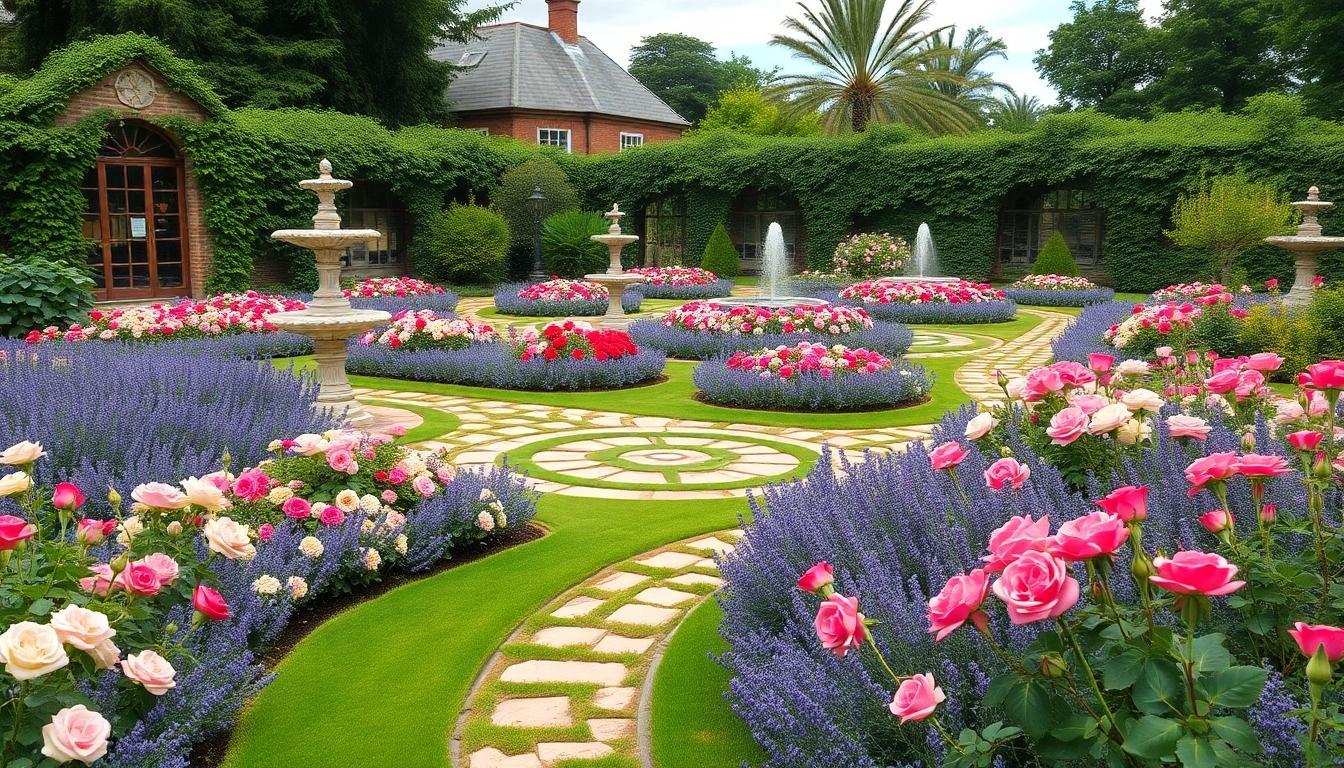
Themed gardens offer a cohesive way to express your personality while creating stunning outdoor spaces. We’ve collected some of the most inspiring garden themes that range from traditional to contemporary designs.
Victorian Garden Elegance
Victorian gardens capture the essence of 19th-century sophistication with their meticulous attention to detail. These formal gardens feature intricate pathways and ornate fountains arranged in perfect symmetry. Roses, lavender, and lilies dominate the floral palette, creating a classic and refined atmosphere. Decorative elements like detailed statues and elegant arbors add architectural interest to these structured spaces. Victorian designs typically maintain clearly defined borders and manicured hedges that showcase the careful planning behind these timeless gardens.
Creating a Romantic English Cottage Garden
English cottage gardens embrace a charming, seemingly unplanned aesthetic that belies their thoughtful composition. These gardens feature a delightful jumble of flowers, herbs, and even vegetables growing together in harmonious chaos. Old English roses, foxgloves, hollyhocks, and cheerful daisies create the backbone of this beloved garden style. The color palette focuses on soft, romantic hues including dreamy pinks, pristine whites, and gentle yellows that evoke a sense of nostalgia. Climbing vines and hanging baskets add vertical interest while creating the abundant, overflowing feeling central to cottage garden charm. This style works particularly well for gardeners who prefer a more relaxed approach where plants appear to grow naturally rather than in rigid formations.
Tiered Garden Displays
Tiered gardens use elevation changes to create dramatic visual impact through layered plantings. Retaining walls separate different levels, allowing for distinctive planting zones and improved drainage. Irises and other perennials thrive in these stepped designs, creating cascading waves of color that draw the eye upward. The vertical dimension of tiered gardens makes them especially suitable for sloped properties that might otherwise be challenging to industry. Each level can feature different plant combinations or a cohesive theme that flows throughout the entire garden space.
Designing a Contemporary Minimalist Flower Space
Contemporary gardens emphasize clean lines and uncluttered spaces that create a sense of calm. These designs typically feature a carefully curated selection of plants with striking architectural forms rather than an abundance of varieties. Native plants often take center stage in modern gardens, providing ecological benefits while maintaining the simplified aesthetic. Geometric hardscaping elements like concrete pavers or metal edging define spaces with precision and purpose. Water features add movement and sound while reinforcing the meditative quality these gardens aim to achieve. The color palette remains intentionally limited, often focusing on various shades of green punctuated by a single accent color for maximum impact. Potted specimens allow for flexibility and can be rearranged as needed to refresh the garden’s appearance without major renovations.
Design Tips for Themed Gardens
Repeating exact plant varieties throughout your garden creates rhythm and cohesion across the space. A simple color palette helps maintain visual harmony while allowing signature plants to stand out as focal points. Incorporating appropriate hardscaping elements like paths, walls, and water features adds structure and functionality to your themed garden. These elements should complement your chosen style—ornate for Victorian, rustic for cottage, and sleek for contemporary designs. Selecting plants that suit your local climate ensures your themed garden will thrive with appropriate care rather than struggle against environmental conditions.
Shade-Loving Flower Garden Ideas for Those Tricky Spots
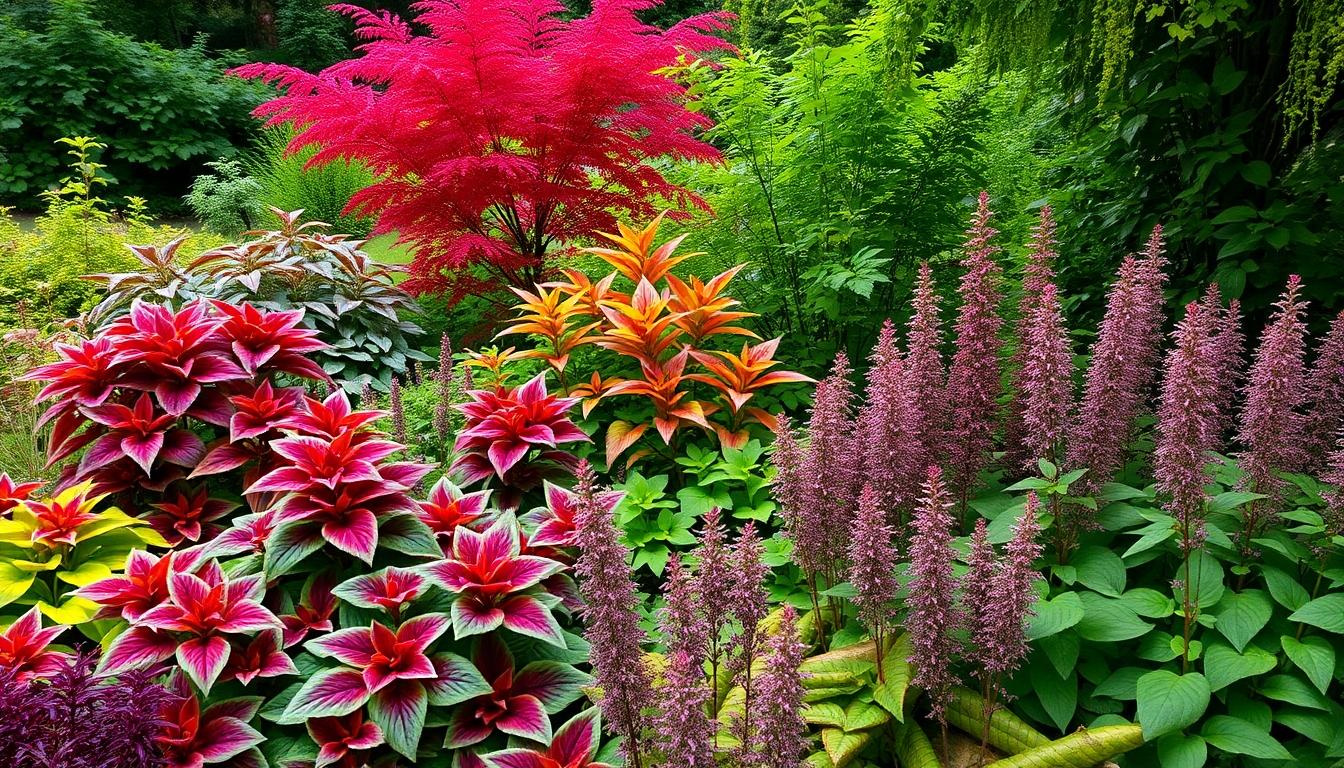
Those challenging shady spots in your garden don’t have to remain barren or boring. With thoughtful plant selection and design strategies, you can transform these areas into lush, colorful retreats that rival their sun-drenched counterparts.
Colorful Shade Plants Beyond Hostas
Coleus offers stunning visual impact with its vibrant foliage in dramatic shades of red, purple, and lime green, thriving beautifully in partial shade conditions. Japanese maples provide elegant seasonal color changes with their burgundy or gold foliage, making them perfect understory plants beneath taller trees. Philodendrons bring tropical flair to shaded areas with their large, glossy deep green leaves that create dramatic textural contrast. Astilbe produces feathery, eye-catching plumes in pink, white, or red hues, performing exceptionally well in damp, shaded locations. Creating layered plantings with green-and-gold (featuring charming star-shaped yellow blooms) and cranesbill (hardy geraniums with vibrant purple or pink flowers) adds diversity and interest to shady borders. Annual flowers like impatiens and begonias deliver reliable, season-long color when many perennials have finished blooming. Canadian wild ginger serves multiple purposes with its distinctive purplish-brown spring flowers and ability to form weed-suppressing groundcover colonies in challenging shaded areas.
Woodland Garden Design Elements
Layered plantings mimic natural forest ecosystems by combining different heights and textures, from Japanese maples and hydrangeas down to snowdrops and shade-loving perennials. Foliage contrast creates visual interest by pairing fine-textured ferns with broad-leaf hostas or bold coleus varieties, building dimension without relying solely on flowers. Pathways and clearings invite exploration through your woodland garden, especially when bordered by shade-tolerant groundcovers like moss after clearing invasive species such as poison ivy. Seasonal interest extends the garden’s appeal throughout the year when you incorporate early bloomers like wild ginger alongside late-season performers such as green-and-gold. Deer-resistant options including cranesbill (zones 4-9) offer practical benefits while attracting pollinators to your shade garden. Canadian ginger thrives in zones 4-6, gradually spreading into attractive colonies that prefer consistently damp soil conditions. Drought-tolerant selections like certain coleus varieties perform surprisingly well in shaded areas, offering vibrant foliage without demanding constant watering throughout the growing season.
Incorporating Edible Flowers into Your Garden Design
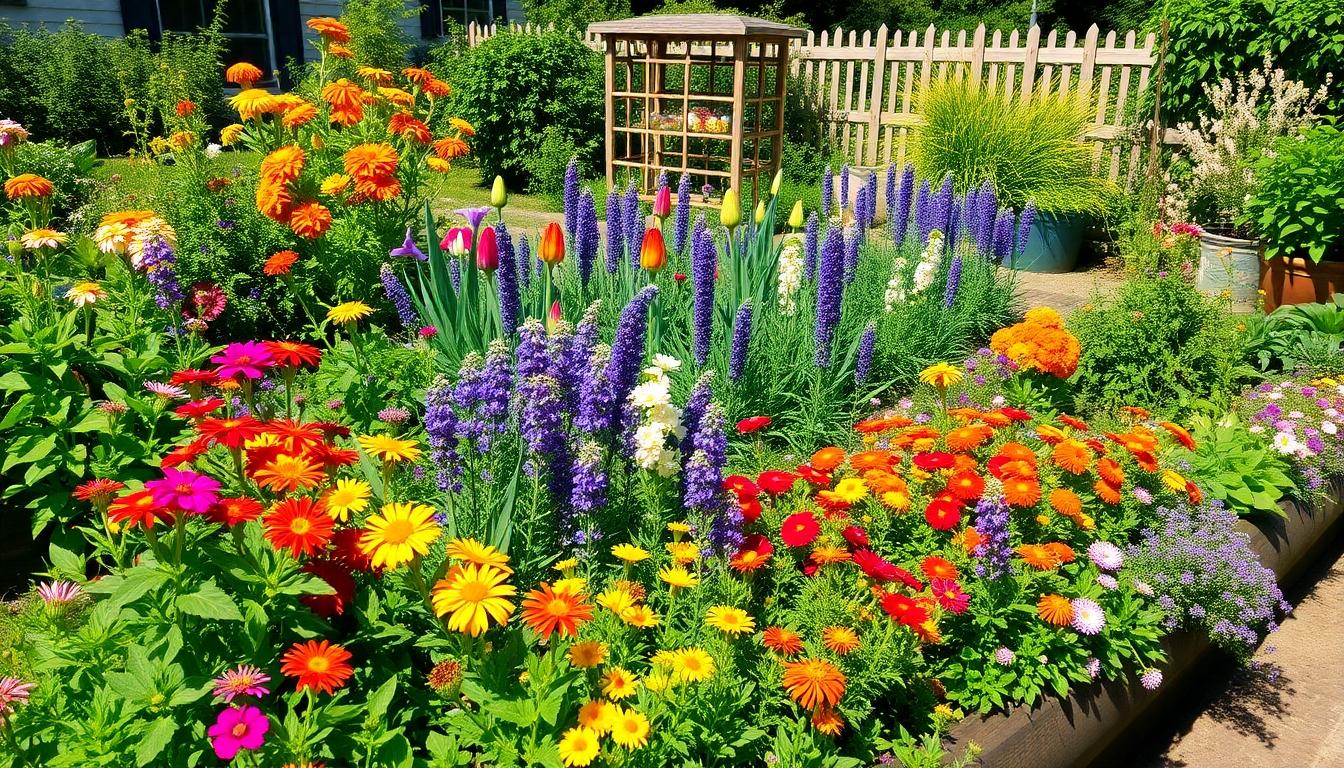
Edible flowers offer a perfect blend of beauty and functionality for your garden space. We’ve compiled some of the most versatile and attractive edible flowers that will transform your garden into both a visual delight and a culinary resource.
Beautiful Flowers That Double as Culinary Ingredients
Borage flowers bring a refreshing cucumber flavor to your dishes, making them excellent additions to salads, fruit platters, and summer drinks. Nasturtiums offer a peppery kick that brightens up salads and works wonderfully as a colorful garnish for special occasions. Lavender and chamomile serve multiple purposes in the garden, from creating aromatic teas to improving homemade beauty products while simultaneously providing visual appeal through their distinctive blooms. Calendula, also known as pot marigold, adds a spicy touch to pasta dishes and herb butters with its vibrant orange and yellow petals. Delicate pansies and violas make stunning decorations for salads and desserts due to their mild flavor and eye-catching colors.
Rose petals have become a staple in Middle Eastern desserts and elegant salads, offering a subtle floral note to sophisticated dishes. Daylily flowers provide dramatic decorative elements to various culinary creations, their bright colors making any plate more appealing. Pineapple sage and yarrow contribute unique flavors to beverages and salads, with pineapple sage delivering a surprising fruity note that complements summer drinks perfectly.
Designing an Ornamental Edible Industry
Raised bed planting allows you to create structured beauty by alternating edible plants like lettuces and peas with decorative flowers such as dahlias and sweet alyssum. This technique creates a layered appearance that combines functionality with visual interest throughout the growing season. Layered planting strategies position taller plants like leeks or sunflowers in background positions while shorter plants including herbs and colorful edible flowers occupy the foreground, creating depth and dimension in your garden space.
Combining edible flowers with non-edible plants in creative layouts maximizes both the aesthetic appeal and practical use of your garden. Plants with similar growing requirements can be grouped together to create thematic beds that serve multiple purposes. Vertical elements like trellises can support climbing edible flowers, adding height and visual interest while saving valuable garden space.
Budget-Friendly Flower Garden Ideas: Creating Beauty Without Breaking the Bank

Creating a stunning flower garden doesn’t require a hefty investment. We’ve compiled practical strategies to help you establish a beautiful garden while keeping costs low.
Starting Flowers from Seeds
Growing flowers from seeds stands as the most economical approach to creating a vibrant garden. Fast-growing varieties like marigolds, zinnias, and sunflowers thrive directly from seed with minimal financial investment. Wildflower seed mixes containing poppies and cornflowers offer an affordable way to create colorful, low-maintenance displays that naturally support local pollinators. Many vegetable and herb seeds can pull double duty in your garden beds, with tomatoes and basil starting easily from seed while providing both visual appeal and practical harvests. Seed packets typically cost a fraction of established plants, allowing you to create abundant displays for just a few dollars. Direct sowing eliminates the need for purchasing specialized equipment, making this approach accessible for gardeners at all experience levels.
Dividing Perennials to Expand Your Garden
Clump-forming perennials offer exceptional value for budget-conscious gardeners through their natural ability to multiply. Hardy geraniums, geums, and astrantia represent ideal candidates for division, allowing you to create multiple new plants from a single purchase. The division process requires simply separating established root clusters into sections with healthy stalks attached, then replanting these divisions in prepared soil. Most divided perennials establish quickly and fill out within one to two growing seasons, dramatically reducing the need for additional plant purchases. This technique works particularly well with hostas, daylilies, and ornamental grasses, which often grow more vigorously after division. Timing divisions during spring or fall when temperatures are mild gives the new plants optimal conditions to establish before extreme weather arrives.
Additional Budget-Friendly Strategies
Vertical Gardening: Wall-mounted racks and hanging baskets maximize growing space without requiring additional land. Trailing plants like petunias create dramatic visual impact while occupying minimal ground space, offering excellent value in small gardens.
Soil and Mulch Improvements: Building healthy soil with homemade compost eliminates the need for expensive soil amendments. Organic mulch materials like shredded leaves protect plants, suppress weeds, and gradually decompose to nourish your garden, creating a self-sustaining network that reduces ongoing costs.
Pre-Designed Displays: Pre-planted hanging baskets and established bedding plants like begonias provide instant color at reasonable prices, especially when purchased late in the garden center season. These ready-made options deliver immediate impact while you develop longer-term, budget-friendly garden features.
Year-Round Planning for a Four-Season Flower Garden
Creating your dream flower garden is a rewarding journey that evolves with each season. Whether you’re drawn to cottage charm butterfly sanctuaries or space-saving vertical displays we hope these ideas have sparked your imagination.
Remember that the most beautiful gardens reflect personal style while respecting your exact growing conditions. Start small experiment with different combinations and don’t be afraid to adapt as you learn what works best in your space.
With thoughtful planning and the right plant selections you’ll soon enjoy a flourishing garden that brings joy through every season. The perfect flower garden isn’t just about aesthetic beauty—it’s about creating a living sanctuary that nurtures both nature and your wellbeing.
Happy gardening!
Frequently Asked Questions
What flowers are best for a cottage garden?
English lavender, foxgloves, delphiniums, hollyhocks, peonies, Shasta daisies, roses, coneflowers, Russian sage, and catmint are excellent choices for cottage gardens. These plants offer a mix of heights, textures, and bloom times to create that classic cottage garden look with year-round interest. Many of these selections are also relatively low-maintenance and attract beneficial pollinators to your garden.
How can I create a butterfly-friendly garden?
Plant nectar-rich flowers like aster, bee balm, black-eyed Susan, blazing star, and butterfly bush. Include host plants such as snapdragons for butterfly reproduction. Incorporate native plants, provide water sources, create shelter areas, and ensure plenty of sunlight. Design with plant diversity and staggered bloom times to support various butterfly species throughout their lifecycles.
What are good options for small space flower gardens?
Utilize vertical gardening with trellises and wall planters. Try container gardening with themed groupings of plants with similar needs. Use climbing plants along fences and consider tiered planters to maximize ground space. Creative solutions include repurposed items as planters and focusing on plants that provide multiple seasons of interest without overwhelming limited space.
Which flowers require minimal maintenance?
Native plants like cornflowers and salvia require little intervention. Drought-tolerant options include yarrow, lavender, and tickseed. Perennials such as black-eyed Susans and bee balm return year after year with minimal care. Incorporate wildflowers, use strategic mulching, and group plants with similar water needs to further reduce maintenance time while maintaining a beautiful garden.
What should I plant for a cut flower garden?
Plant a variety of flowers with staggered bloom times from spring to fall, including tulips, zinnias, dahlias, cosmos, and sunflowers. Arrange beds with tall flowers at the back and shorter ones in front. Harvest flowers in early morning when stems are hydrated and buds are just beginning to open. Include diverse flower shapes and incorporate pollinator-friendly species to boost overall garden productivity.
How can I design a themed flower garden?
Choose a cohesive theme like Victorian (formal structure, classic flowers), English cottage (relaxed mix of flowers and herbs), or contemporary (clean lines, native plants). Use repetition of key plants for visual unity and select a harmonious color palette that reflects your chosen theme. Add appropriate hardscaping elements like paths or structures that complement your garden style.
What flowers grow well in shade?
Coleus, Japanese maples, astilbe, hostas, bleeding heart, foxglove, coral bells, and ferns thrive in partial to full shade. Create layered plantings with various heights and textures to add visual interest. Consider woodland garden design elements and incorporate deer-resistant varieties if needed. Even in shade, you can create vibrant displays by focusing on foliage color and texture along with flowers.
Which flowers are both ornamental and edible?
Borage, nasturtiums, lavender, calendula, violets, pansies, and chamomile serve both decorative and culinary purposes. These flowers can enhance salads, desserts, and beverages while adding beauty to your garden. Design ornamental edible gardens using raised beds and layered planting strategies, combining edible flowers with herbs and vegetables for a functional yet attractive garden space.
How can I create a flower garden on a budget?
Start flowers from seeds rather than buying mature plants, focusing on fast-growing varieties and wildflower mixes. Divide existing perennials to expand your garden for free. Share plants with neighbors or join plant swaps. Improve soil with homemade compost instead of store-bought amendments. Consider vertical gardening to maximize space and look for end-of-season sales for discounted plants.
When is the best time to plant a flower garden?
The optimal planting time depends on your climate zone and the types of flowers. Generally, spring and fall offer ideal conditions with moderate temperatures and adequate moisture. Plant summer-blooming annuals and perennials after danger of frost has passed in spring. Fall is best for spring-blooming bulbs and many perennials, allowing root systems to establish before winter dormancy.

